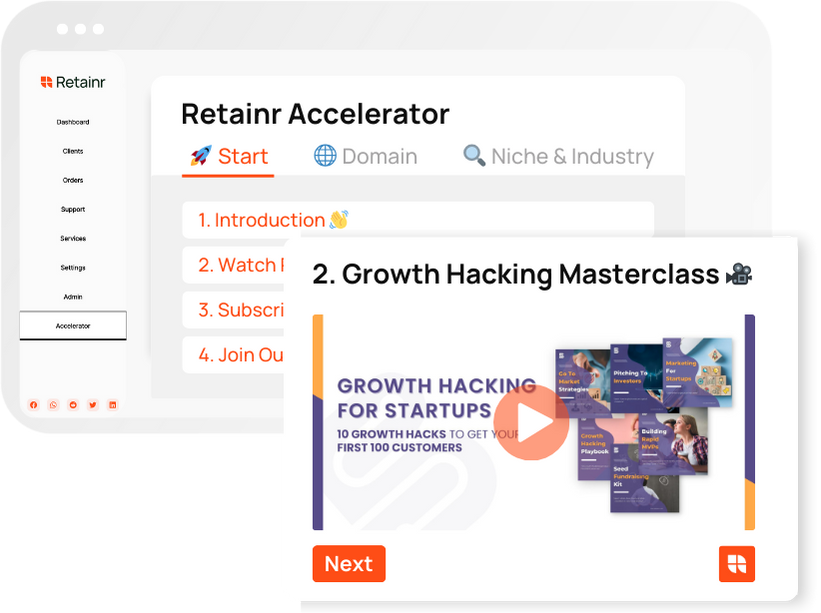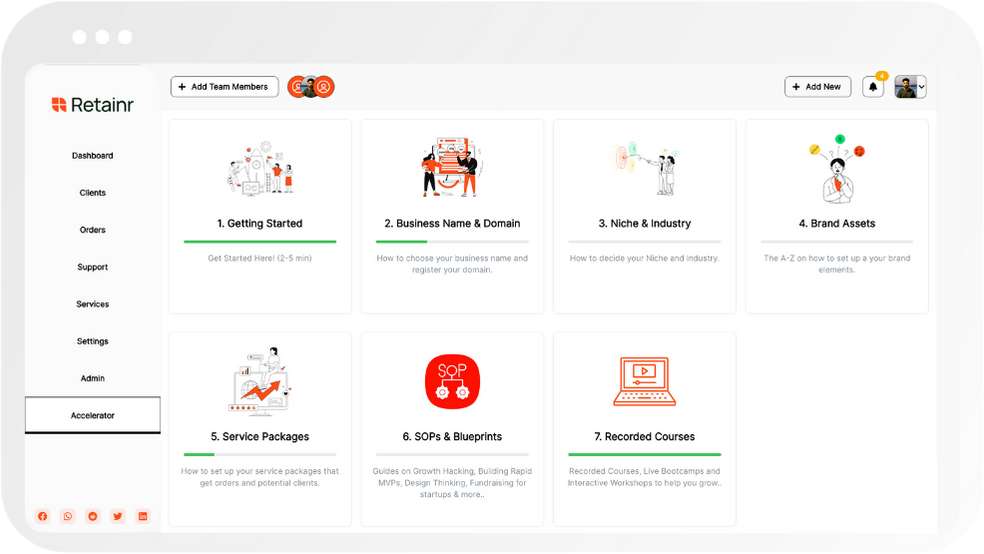
How to Launch a Profitable Online Course: 8 Key Strategies
Build with Retainr
Sell your products and services, manage clients, orders, payments, automate your client onboarding and management with your own branded web application.
Get Started1. What are the 8 key strategies to launch a profitable online course?
8 Key Strategies to Launch a Profitable Online Course
To succeed in the competitive online learning market, it's crucial to develop and implement a strategic plan. Here are the eight key strategies that can help you launch a profitable online course:
- Identify Your Niche: To differentiate your course from others, find a unique angle that serves a specific audience.
- Know Your Audience: Understand the problems and needs of your target audience. Design your course to provide them the right solutions.
- Quality Content: Ensure your course offers high-quality, engaging, and useful material. Use various formats to agree with different learning styles.
- Test Run: Validate your course by initially offering a short, free version. Evaluate the feedback for improvements.
Additional Strategies for Success
Continuing the list, the final key strategies are:
- Pricing: Price your course competitively. Consider the value delivered and current market standards.
- Marketing: Use various marketing tools to promote your course such as social media, email marketing, and SEO.
- After Sales Support: Offer continuous customer support, and update the course when necessary, to maintain ongoing relevance.
- Monitor and Redefine: Regularly track the performance of your course and update it based on learner’s feedback and market trends.
A Quick Summary:
| Strategy | Description |
|---|---|
| Identify Your Niche | Define your unique selling point |
| Know Your Audience | Understand your audience's problems and needs |
| Quality Content | Provide quality, engaging, and relevant material |
| Test Run | Receive and implement feedback for improvements |
| Pricing | Price competitively based on value and market standards |
| Marketing | Promote your course to reach potential customers |
| After Sales Support | Offer consistent customer support and necessary updates |
| Monitor and Redefine | Regularly evaluate and update your course |
2. How do I identify my target audience for an online course?
Identifying Your Target Audience
Recognizing who your target audience is, proves crucial to the success of an online course. Your audience should correspond to the people who are interested in your course topic and are willing to pay for the knowledge you impart. Thus, to correctly identify your target audience, three key elements require consideration.
- Define Your Course Topic: Shape your course around your expertise or passion, which will then determine who your target learners are. For instance, if you're an expert in digital marketing, your audience will likely be individuals aiming to build or improve their marketing skills.
- Market Research: Conduct extensive market research to understand the needs and wants in your chosen field. This could include surveys, questionnaires, or interviews with potential learners. You can also review existing courses on similar topics and study their audience’s profiles and feedback.
- Customer Segmentation: Divide potential learners into various categories based on factors like age, learning goals, professional background, and geographic location. This will help you tailor your content to meet the unique needs of each segment.
Understanding Your Audience's Needs
Once you have identified your target audience, your next step is to understand their specific needs and preferences. This can be achieved through actively engaging with them, analysing their feedback, and studying their learning patterns. The more specific you get, the better able you'll be to deliver a course that resonates with them, consequently driving better enrollment rates and course completion percentages. Here's a simple understanding:
| Audience Segment | Learning Needs | Course Preference |
|---|---|---|
| Working Professionals | Need to upgrade skills to align with industry demands | Prefers weekend or after-work hours tutorials, real-world case studies |
| Students | Need to supplement academic knowledge and gain technical skills | Prefers interactive, gamified lectures with more visuals, flexible schedule |
Reaching out to Your Target Audience
After identifying and understanding your audience, it's time to reach out to them. The promotional strategy should be based on where your target learners spend their time online, be it Instagram, YouTube, LinkedIn, or specialized forums. Offering a free introductory lesson or webinar can be a good start to engage your audience. Email marketing, partnerships with industry influencers, and educational platforms can also be effective promotional tools.
3. What steps should I follow to create a compelling content for an online course?
Step 1: Define Your Course Objectives and Target Audience
Start out by clearly defining the overarching objective of your course. What skills or knowledge will your learners acquire upon completion? This will guide your content creation process. Identify your target audience too. Understanding their needs, learning patterns and proficiency levels will help you tailor your content in a way that resonates with them.
- Course Objectives: Define specific, measurable, attainable, relevant, and time-bound (SMART) goals.
- Target Audience: Establish detailed learner personas including their demographic details, career background, and educational level.
Step 2: Decide on the Format of Your Course
Deciding on the format is a crucial step in creating a profitable online course. A mixture of formats like video lectures, downloadable resources, quizzes, and interactive elements can make the course engaging. Video contents may be time-consuming to create but they typically have better engagement rates. However, the format you choose largely depends on your course objectives and target audience's learning preference.
| Format | Description |
|---|---|
| Video lectures | Visual presentations of your course content |
| Downloadable resources | PDFs, word documents, spreadsheet files, etc. for offline study |
| Quizzes | Assessments that evaluate learners' understanding |
| Interactive elements | Discussion boards, live webinars, group projects |
Step 3: Develop High-Quality Course Content
An outstanding course content should be easy to understand, visually appealing, and engaging. Start with creating an outline - this will serve as your roadmap, detailing what will be covered in each module. High-quality graphics and visuals, such as infographics and charts, can make complex topics easier to understand. Lastly, engage learners by integrating interactive elements like quizzes, real-life scenarios, and exercises.
- Course Outline: A detailed breakdown of each module and the lessons within.
- Visuals and Graphics: Include appealing images, infographics, charts, and diagrams to illustrate key points and concepts.
- Interactivity: Make use of quizzes, real-life scenarios, and exercises to boost engagement and knowledge retainment.
4. How can I price my online course to maximize profit?
Pricing Your Online Course Effectively
Deciding the price of your online course is crucial as this significantly impacts profitability. To optimize profits, consider the following strategies:
- Demand-based pricing: Start with higher prices when your course is new and there is anticipation and excitement among the target audience. You can offer discounts and sales later on.
- Cost-based pricing: Cover your production and marketing expenses. At the same time, add a proportion of profit on top of your costs.
- Competitor-based pricing: Understand what similar courses in the market are charging and price competitively. Avoid underpricing or overpricing.
Strategies to Enhance Your Profitability
There are several strategies you can employ to further enhance the profitability of your online course:
| Strategy | Description |
|---|---|
| Bundling | Package two or more of your courses together at a reduced rate. |
| Membership plans | Offer continuous access to your courses for a monthly or annual fee. |
| Upselling and cross-selling | Propose higher-priced offerings, or recommend relevant courses to your subscribers. |
Effective Price Communication
The way you communicate your price can also play a vital role in maximizing profit. Implement these methods for optimal results:
- Price anchoring: Present the original price next to the discounted price to show value.
- Payment plans: Make your course accessible to those who can’t pay upfront by offering a payment plan.
- Money-back guarantee: Remove purchase risk, which can encourage more students to sign up.
5. How can I market my online course effectively?
Identify Your Target Audience
Marketing your online course begins with understanding your target audience. You have to know who would find your content beneficial. Consider demographic information like age, occupation, and education level. More importantly, think about the problems your target audience faces that your course could help solve.
Create A Marketing Plan
With a clear understanding of your target audience, you can devise a marketing plan. It should include:
- SEO Strategies: Use keywords relevant to your content in your course description and promotional materials to attract organic traffic from search engines.
- Email Marketing: Emailing potential students about your course is another effective strategy. Make sure the content is engaging and prompts them to take action.
- Social Media Marketing: Social media networks such as Facebook, Instagram, and LinkedIn are powerful tools for advertising your course. Share engaging content and be active in relevant communities to attract students.
Track Performance and Improve
| Tools | What They Do |
|---|---|
| Google Analytics | Tracks website traffic, user demographics, and how users came to your site |
| Facebook Insights | Provides data on post reach, page visits, and follower activity on your Facebook page |
| Email Marketing Software | Measures open rates, click-through rates, and conversion rates of your email campaigns |
The key to successful marketing is regular performance tracking. Using tools like Google Analytics, Facebook Insights, or email marketing software, you can monitor the effectiveness of your marketing strategies. Identify what's working and what's not, then adjust accordingly. Over time, this consistent tweaking and improving will ensure that your course reaches the most interested learners and achieves profitability.
6. What platforms can I use to launch my online course?
Choosing the Right Platform for Your Online Course
Choosing a platform to launch your online course is one of the most critical steps in creating a profitable offering. There are numerous platforms available, each with their own unique pros and cons. You would want to consider factors such as pricing, accessibility, features, and reliability while opting for a platform. Below are a few to consider:
- Teachable: Teachable is one of the most popular platforms for course creators. It offers a relatively affordable pricing structure, robust features like quizzes and course completion certificates, and integration with marketing tools.
- Thinkific: Thinkific provides a highly customizable platform that allows you to personalize your course's look and feel. It also offers features like surveys, quizzes, and the ability to host live webinars.
- Udemy: Udemy is a massive open online course (MOOC) provider that allows creators to upload courses for free but charges a percentage of sales. Its key strengths are the large student base and ease of use.
- Podia: Podia is a platform that accommodates a variety of digital products, including online courses, digital downloads, and membership sites. It is known for its simplicity and excellent customer support.
Comparing Course Creation Platforms
To help you determine which platform might be the best fit for your course, here is a comparison table of some of the mentioned platforms:
| Platform | Pricing | Features | Ease of Use |
|---|---|---|---|
| Teachable | $29 - $399 per month | Quizzes, course completion certificates, course compliance | High |
| Thinkific | Free - $499 per month | Quizzes, surveys, custom themes, live webinars | High |
| Udemy | Charges 50% of sales | Large student base, certificate of completion | High |
| Podia | $39 - $199 per month | Course creation, digital downloads, membership sites | Medium |
Remember your choice of a platform plays a significant role in your course's profitability. Consider your specific needs and choose wisely.
7. How can I ensure that my online course meets the needs of my audience?
Identifying Audience Needs
To ensure your online course meets the needs of the audience, first you need to identify who your audience is and what they are seeking from your course. This can be done by conducting market research, surveys, and interviews, or by analyzing customer data if already available. Once you've identified your audience's needs, structure your course content to address these needs.
- Market Research: Researching competitor courses and reading their reviews can provide insights into what potential students are expecting from such courses.
- Surveys & Interviews: You can directly ask your audience or potential learners what they are looking for in an online course. Use surveys or one-on-one interviews to gather this information.
- Customer Data Analysis: If you have previously launched courses or related products, analyzing customer behavior and feedback data can offer valuable information about their needs and expectations.
Developing Course Content
With a clear understanding of the audience's needs, the next step is to develop course content that meets those needs. This could involve creating diverse and inclusive content, ensuring the course is easy to navigate, and including practical applications to ensure knowledge acquisition.
- Diverse and Inclusive Content: Develop course content that is engaging and caters to different learning styles. Include videos, text, quizzes, and interactive components where applicable.
- User-friendly Design: The online course should be easy to navigate and user-friendly, with clearly labelled sections and easily locatable resources.
- Practical Applications: Include real-world applications and examples in your course content to help learners understand how the knowledge can be applied practically.
Continuous Evaluation and Improvement
Finally, garner feedback from your students and continuously improve your course based on their experiences. Creating feedback loops, implementing improvements, and updating your course regularly are critical for ensuring your course continues to meet your audience's needs.
| Type of Feedback | Action to be taken |
|---|---|
| Course Content Feedback | Modify the content if students feel certain aspects are not clear or useful. |
| Technical Feedback | Address any technical issues in the platform to avoid disruptions in learning. |
| General Experience Feedback | Enhance the course experience by responding to student suggestions. |
8. What are some tips for improving student engagement and retention in my online course?
Tips to Improve Student Engagement
Student engagement in your online course vastly influences the level of success your course achieves. Here are some crucial steps to ensure heightened student engagement:
- Interactive Content: Think beyond the standard slide decks. Employ quizzes, interactive videos, or even online games to grip student interest.
- Live Sessions: Offer live sessions where the students can interact directly with the instructor. Direct interaction often results in greater engagement and understanding.
- Peer Interaction: Create an environment encouraging peer collaboration. It could be in the form of discussion forums, group projects, or shared assignments.
- Feedback Mechanism: Personalize feedback for individual students' assignments or tests. Personalized responses keep students engaged and motivate them to improve.
- Real-world Examples: Use real-world examples and case studies related to the course content. These make abstract concepts relatable and understandable.
Strategies to Retain Students
Retention of students is another key metric defining the success of your online course. Here are a few strategies to ensure that you can keep your students interested:
- Regular Communication: Maintain consistent communication with the students. This can be updates about the course, reminders of pending assignments, or newsletters providing exciting information about the course.
- Flexible Schedule: Offer flexibility in terms of course schedule. The opportunity to learn at their own pace can be a significant retention factor for many students.
- Simplified Content: Create simple, straightforward, and easily digestible content. If the students find the course hard to understand, it’s likely they might abandon it.
- Rewards and Recognition: Appreciate and reward students who perform well or show significant improvement. This could be in the form of digital badges, certificates, or even a special mention in the newsletter.
Improving Student Engagement and Retention: Summary
| Improvement Area | Key Strategies |
|---|---|
| Student Engagement | Interactive content, live sessions, peer interaction, feedback mechanism, real-world examples |
| Student Retention | Regular communication, flexible schedule, simplified content, rewards, and recognition |
9. How can I measure the success and profitability of my online course?
Track Key Performance Indicators (KPIs)
The profitability and success of your online course can be best measured by tracking key performance indicators (KPIs). Some important KPIs for online courses are:
- The number of registrations or enrollments
- Course completion rates
- Student engagement rate which could include participating in discussion forums or submitting assignments
- Customer satisfaction scores gathered through surveys or feedback forms
Monitor Financial Metrics
Besides the KPIs, you should also closely monitor some crucial financial metrics. These would provide a concrete view of the profitability of your online course. Here are a few such metrics:
| Financial Metric | Description |
|---|---|
| Revenue | The total income generated from the sales of your online course |
| Net Profit | The revenue minus the total costs of producing, marketing, and delivering your course |
| Return on Investment (ROI) | This is calculated by dividing the net profit by the total cost. This percentage indicates how much profit the course has made relative to the cost |
Analyze Student Success and Feedback
The success and effectiveness of your course is largely hinged on the success and satisfaction of your learners. Therefore, pay close attention to the following:
- Completion Rate: This is the percentage of students that complete the course. A high completion rate often signifies engaging and valuable content.
- Success Rate: This could be measured by quizzes or assessments. High scores often indicate effective teaching.
- Feedback and Testimonials: These could offer valuable insights into what worked well and what areas need improvement.
10. What are some common mistakes to avoid when launching an online course for profit?
Common Mistakes to Avoid When Launching an Online Course
Crafting and launching an online course might be exciting, but it's also easy to slip up and fall into some common traps. If you want your course to be profitable, avoiding these mistakes is crucial. Below are some of the common errors people make:
- Not clearly defining the target audience: Without understanding who your course is for, you can't effectively market it or create content that truly meets your audience’s needs.
- Setting unrealistic expectations: Avoid promising results you can't guarantee or moving too quickly through complex material. It's essential to ensure that the content aligns with what you promise in your marketing message.
- Ignoring marketing: Many course creators make the error of assuming their course will sell itself. Even the best courses need a smart, comprehensive marketing strategy.
Furthermore, technical and quality-related problems often crop up in the production and delivery of online courses. Some of these critical issues are illustrated in the following table:
| Technical/Quality Issue | Explanation |
|---|---|
| Poor Audio and Video Quality | Low-quality audio or video decreases the perceived value of your course, potentially leading to poor reviews and low sign-ups. |
| Lack of Interactive Elements | Engagement is critical in online learning. Without interactive elements like quizzes or discussion forums, students may lose interest. |
| Inadequate Course Planning | Churning out a course without proper organization may result in a disjointed, confusing learning experience that devalues your course. |
Successful course creation and profit generation come as a result of understanding your audience, setting realistic expectations, strategizing marketing efficiently, and putting considerable efforts into creating quality content. Steer clear from these common online course pitfalls to improve your chances of profitability.
Conclusion
Launch a Profitable Online Course with These Key Strategies
Online learning is growing exponentially, making it an opportune time to launch an online course. With the right strategies, your course can bring in significant revenue. These eight key strategies guide you on How to Launch a Profitable Online Course.
Identify Your Market
Since, identifying your audience is paramount. Understanding their needs and problems will help shape course content that is relevant and engaging.
Create Quality Content
Nothing tops quality. Your course should offer value for money, so invest time in making it comprehensive, practical, and engaging.
Use Interactive Learning Methods
Interactive teaching methods like quizzes, videos, and chat rooms keep learners motivated and engaged, and aid retention of the course content.
Effective Pricing Strategy
Price your course effectively - ensuring that it represents value for money while also generating profit.
Promote Your Course
Marketing is crucial. Utilize social media, blogs, email marketing, SEO, and even influencers to get the word out about your course.
Measure and Revise
Feedback is vital. Use it to constantly revise and improve your course, making it more refined and customer-centric.
Repeat Successful Elements
Find out what works in your course and stick to it for future courses. Never experiment just for experimentation's sake. Stick to what’s proven and successful.
Choose the Best Platform for Your Course
The effectiveness of your course delivery can make or break your online course. Use trusted, reliable platforms that cater to your specific needs. One such platform is Retainr.io, a whitelabel software that allows you to Sell, Manage Clients, Orders & Payments with Your Own Branded App. This effective management tool can streamline your course to run smoothly and efficiently. Try Retainr.io for a hassle-free experience in running your online course.
Boost Your Agency Growth
with Retainr Accelerator
Uncover secrets, strategies, and exclusive blueprints to take your agency's growth to the next level — from marketing insights to effective presentations and leveraging technology.

SOPs, Cheatsheets & Blueprints
Leverage 50+ SOPs (valued over $10K) offering practical guides, scripts, tools, hacks, templates, and cheat sheets to fast-track your startup's growth.
Connect with fellow entrepreneurs, share experiences, and get expert insights within our exclusive Facebook community.
.jpg)

Join a thriving community of growth hackers. Network, collaborate, and learn from like-minded entrepreneurs on a lifelong journey to success.

Gain expertise with recorded Courses, Live Bootcamps and interactive Workshops on topics like growth hacking, copywriting, no-code funnel building, performance marketing and more, taught by seasoned coaches & industry experts.

.jpg)

.jpeg)


